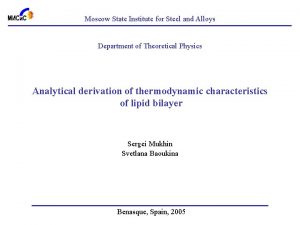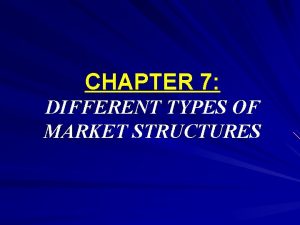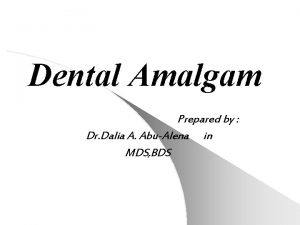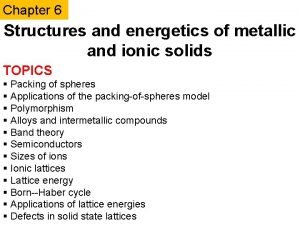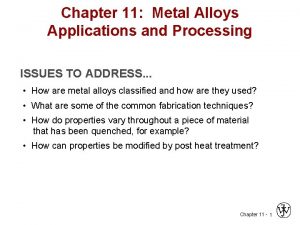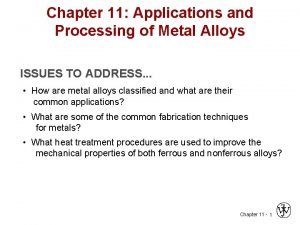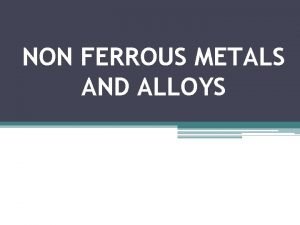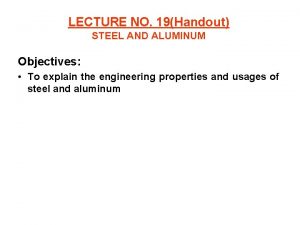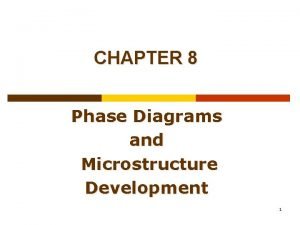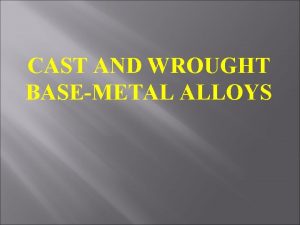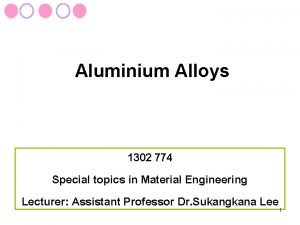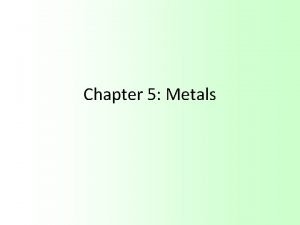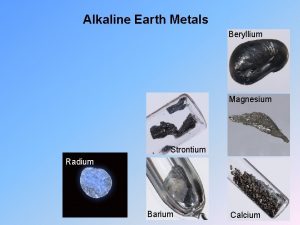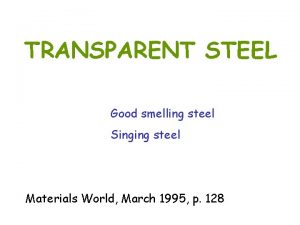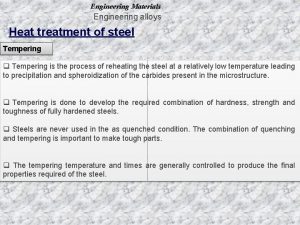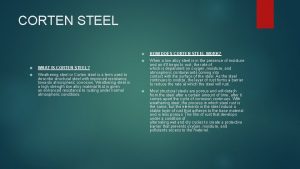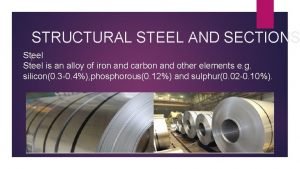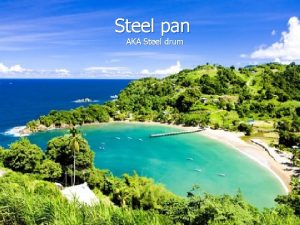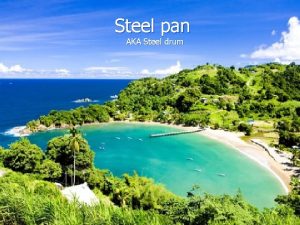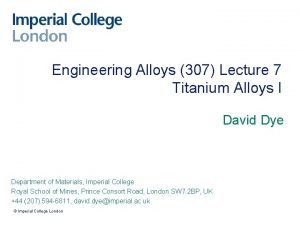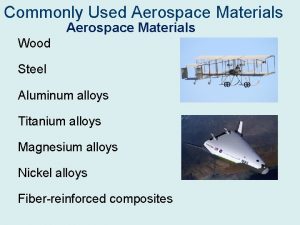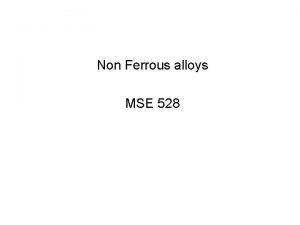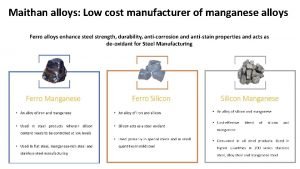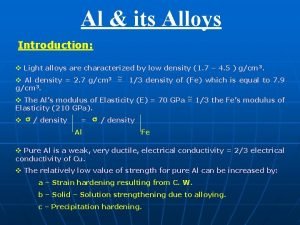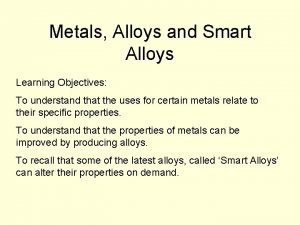Engineering Materials Engineering alloys Steel production q Materials
















- Slides: 16

Engineering Materials Engineering alloys Steel production q. Materials used to produce pig iron ØIron ore (Fe 2 O 3) : -Processed ore at the start of the process has about 65% iron. Ø Coke (carbon): - In a blast furnace, ore is heated in the presence of carbon—this allows oxygen in the ore to react with carbon to form gases. Ø Limestone: - Helps to remove impurities. Ca. CO 3 ØImpurities (slag) float on the top of melt. Ø Requires about 3. 2 tons of raw materials to produce 1. 0 ton of steel.

Engineering Materials Engineering alloys Steel production q. Materials used to produce pig iron ØIron ore (Fe 2 O 3) : - Ø Coke (carbon): Ø Limestone: Ca. CO 3 Pig iron: Raw iron, the immediate product of smelting iron ore with coke and limestone in a blast furnace. Pig iron has a very high carbon content (4 -5%, which makes it very brittle and not very useful directly as a material.

Engineering Materials Engineering alloys Steel production q. Materials used to produce pig iron ØIron ore (Fe 2 O 3) : Ø Coke (carbon): Ø Limestone(Ca. CO 3): Pig iron: Raw iron, the immediate product of smelting iron ore with coke and limestone in a blast furnace. Pig iron has a very high carbon content (4 -5%, which makes it very brittle and not very useful directly as a material. q Three types of furnaces have been used for refining pig iron (or scrap steel) to refined steel; Ø Open hearth (very old no longer used) Ø Basic oxygen Ø Electric arc

Engineering Materials Engineering alloys Iron- Carbon phase diagram q To refine steel from either scrap or pig iron, the amount of carbon must be carefully controlled. q Fig. shows a typical iron-carbon diagram. This helps us to understand how this control is done. The following alloying elements e. g. , nickel, manganese, nitrogen, copper, chromium, silicon, aluminum, titanium, vanadium, niobium, molybdenum, tungsten, etc). Could be added to an ironcarbon alloy (steel).

Engineering Materials Engineering alloys Iron- Carbon phase diagram Ø Ferrite α (α-iron): Iron in a BCC structure. Maximum solubility of carbon in ferrite is low (0. 02%C). Ø Austenite (gamma-iron): Iron with a FCC structure. Due to FCC structure, more carbon atoms can be accommodated. Maximum solubility of carbon in austenite is 2. 08%. Ø Cementite (or iron carbide, Fe 3 C): This forms when solubility of carbon in solid iron is exceeded. Fe 3 C contains 6. 67%C. Cementite is present in all commercial steels. Ø Pearlite: Lamellar structures of α ferrite (α -iron) and cementite.

Engineering Materials Engineering alloys Iron- Carbon phase diagram Ø Ferrite (α), Pearlite, and Cementite (or iron carbide) greatly influence the properties of steel. q Ferrite has relatively low strength but is very ductile. q Iron carbide has high strength but little ductility q Combining these two in different proportions alters the mechanical properties of steel. q In general, increasing carbon content increases the strength but reduces ductility.

Engineering Materials Engineering alloys Iron- Carbon phase diagram q Left side—pure iron (0% carbon) goes through two transformations as temp increases; Ø Pure iron below 912°C has BCC crystalline structure called ferrite. Ø At 912°C, ferrite changes to a FCC structure called austenite (γ). Ø At 1394°C, iron returns to a BCC structure. Ø The high and low ferrites identified as δ and α ferrite. q Carbon goes into solution with α ferrite at temps between 500°C and 912°C—but solubility limit for carbon is very low—about 0. 02% at 727°C.

Engineering Materials Engineering alloys Iron- Carbon phase diagram q At low temps and to the right of the solubility limit line, α ferrite and iron carbide (Fe 3 C) coexist. q From 738°C to 1154°C, the solubility of carbon in the austenite increases from 0. 68 to 2. 08%. The solubility of carbon in austenite is greater than in α ferrite because of the FCC structure of austenite. q At 0. 68% carbon and 738°C, a eutectoid reaction occurs, that is, a solid phase change occurs when either the temperature or carbon content changes.

Engineering Materials Engineering alloys Iron- Carbon phase diagram q The eutectoid reaction describes the phase transformation of one solid into two different solids (or S 1=S 2+S 3). In the Fe-C system, there is a eutectoid point at approximately 0. 68% carbon, 738°C. The phase just above the eutectoid temperature is austenite. Consider what happens as this phase is cooled through the eutectoid temperature (738°C). q Austenite –> ferrite + iron carbide (Fe 3 C).

Engineering Materials Engineering alloys Iron- Carbon phase diagram q At carbon contents less than eutectoid composition, hypoeutectoid (or containing less than 0. 68% carbon) alloys are formed. Most structural steels are hypoeutectoid (about 0. 1 to 0. 3% carbon). q For example, at 0. 25% carbon, and above about 810°C, solid austenite exists as grains of uniform material. As the temp drops, α ferrite is formed from 810 to 738°C and accumulates at the grain boundaries of the austenite.

Engineering Materials Engineering alloys Iron- Carbon phase diagram

Engineering Materials Engineering alloys Iron- Carbon phase diagram q When temp drops below 738°C, the austenite will transform to pearlite (alternate layers of α ferrite and iron carbide). Pearlite is not a phase but a mixture of two phases.

Engineering Materials Engineering alloys Iron- Carbon phase diagram

Engineering Materials Engineering alloys Heat treatment of steel Properties of steel can be altered by applying a variety of heat treatments. q Annealing: Heat to austenite range (about 10 C above the austenite line) then slowly cool to room Temperature, results in softer steel, reduced internal stress, increases ductility and toughness.

Engineering Materials Engineering alloys Heat treatment of steel Properties of steel can be altered by applying a variety of heat treatments. q Normalizing: same as annealing but heat to 40 C above the austenite line. Then air cool. Produces a uniform, fine-grained structure. Considered as a corrective treatment and not for strengthening.

Engineering Materials Engineering alloys Heat treatment of steel Quenching q Material is heated up to the suitable temperature for hardening and then (quenched) cooled rapidly by immersing the hot part in water, oil or another suitable liquid to transform the material to a fully hardened structure. q Hardened (quenched) materials are tempered to improve their dimensional stability and toughness.
 Moscow institute of steel and alloys
Moscow institute of steel and alloys Sebutkan 3 proses produksi multimedia
Sebutkan 3 proses produksi multimedia Fekkai shampoo
Fekkai shampoo What is a “bulk-gaining industry”?
What is a “bulk-gaining industry”? Microfusion cast & alloys
Microfusion cast & alloys Dental amalgam composition
Dental amalgam composition Substitutional alloy examples
Substitutional alloy examples Calister
Calister Applications and processing of metal alloys
Applications and processing of metal alloys Shape memory alloys lecture notes
Shape memory alloys lecture notes Non ferrous alloys definition
Non ferrous alloys definition Aluminum and its alloys
Aluminum and its alloys Development of microstructure in isomorphous alloys
Development of microstructure in isomorphous alloys Wrought alloys in dentistry
Wrought alloys in dentistry Aluminum and its alloys
Aluminum and its alloys Interstital alloys
Interstital alloys Magnesium barium alloys
Magnesium barium alloys
